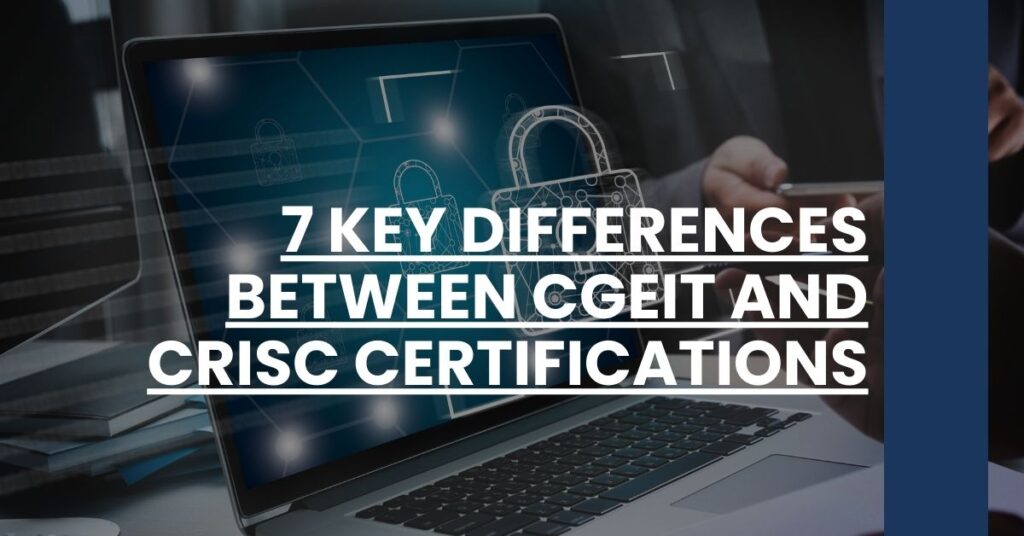Are you navigating the intersection of IT governance and risk management? Choosing between CGEIT vs CRISC certifications is pivotal.
This article zeroes in on the essential differences that can sculpt your career trajectory in IT. Understand the unique aspects and opportunities each certification offers, ensuring you make an informed decision aligned with your professional aspirations.
No filler, just facts; let’s explore what sets CGEIT and CRISC apart.
- 1. Focus Areas: Governance vs. Risk Management
- 2. Career Advancement Opportunities
- 3. Prerequisites and Eligibility Criteria
- 4. Exam Content and Structure
- 5. Recognition and Credibility within the Industry
- 6. Maintenance and Continuing Education
- 7. Comparative Cost Analysis
- Aligning Certifications with Business Needs
- Trends in IT Governance and Risk Management
- Conclusion: Making the Right Choice for Your Career
1. Focus Areas: Governance vs. Risk Management
If you’re weighing the merits of a CGEIT certification versus CRISC, understanding the core focus of each is crucial. At first glance, Certified in the Governance of Enterprise IT (CGEIT) and Certified in Risk and Information Systems Control (CRISC) may seem similar, but they cater to different professional landscapes within the IT domain.
- CGEIT: This certification orbits around the governance aspect of enterprise IT. It encapsulates the frameworks and strategic management required for tech governance efficacy. By achieving CGEIT, you demonstrate an adeptness in managing and guiding enterprise information technology with an emphasis on aligning IT goals with business strategies.
- CRISC: In contrast, CRISC hones in on identifying and managing IT risk. This specialty is all about implementing robust control systems and mitigating IT risks. A CRISC designation signifies your prowess in risk management processes and your capabilities to enhance the IT security posture of an organization.
When deciding on cgeit vs crisc, consider where you see your expertise providing the most value. Are you inclined towards strategically deploying IT resources in line with business objectives, or does the thrill of identifying and mitigating risks in complex IT environments appeal more to you?
2. Career Advancement Opportunities
Pursuing either one of these coveted certifications can be a game-changer for your professional career, with each opening distinct avenues for growth.
For CGEIT Holders:
Achieving CGEIT can catapult you into the senior echelons of IT leadership, setting you up for roles such as:
- Chief Information Officer (CIO)
- IT Governance Director
- Enterprise IT Architect
For CRISC Professionals:
CRISC, on the other hand, paves the way for careers deeply rooted in IT risk assessment and security:
- IT Risk Analyst
- Information Systems Control Manager
- Cybersecurity Professional
Weigh these career pathways in the context of cgeit vs crisc certifications. Are you aspiring to a future in executive IT governance, or do you seek to cement your expertise in risk strategies and information systems control?
3. Prerequisites and Eligibility Criteria
Before diving into either CGEIT or CRISC, let’s demystify the prerequisites needed for these certifications:
CGEIT: You’re expected to come armed with five years of experience, showcasing your involvement in IT governance, risk management, or alignment with corporate strategy. This background solidifies the expectation that you can take on the mantle of IT governance with authority.
CRISC: A bit leaner on requirements, CRISC calls for just three years in IT risk management and control duties, ensuring you have had ample exposure to the intricacies of risk management across various IT scenarios.
This comparison sheds light on the professional journeys suitable for each certification. Let it guide your decision-making process as you consider which credential aligns with your current expertise and where you envision your career trajectory.
4. Exam Content and Structure
Diving deeper into cgeit vs crisc certifications, let’s unravel the fabric of the exams themselves.
For CGEIT, expect to encounter a 150-question examination that touches upon four central domains, from the nitty-gritty of running enterprise IT to the strategic orchestration of IT resources. Your prowess in managing IT governance will be put to the test in a variety of scenarios designed to challenge and evaluate your strategic thinking and workplace applicability.
CRISC also presents a 150-question battleground but zeroes in on areas like identifying and managing IT risk, and overseeing information systems controls. This exam gauges your ability to not just understand but actively fortify your organization against varied IT threats and vulnerabilities.
Arming yourself with the layout and substance of these exams will sharpen your preparation and influence the trajectory of your professional development in notable ways.
5. Recognition and Credibility within the Industry
In terms of industry clout and prestige, both CGEIT and CRISC have carved out significant reputations.
- CGEIT: This certification is often synonymous with seasoned professionals, lauded for establishing and fine-tuning IT governance mechanisms. It can be your ticket to obtaining high-level trust and authority within an organization.
- CRISC: A polestar of a credential for those aiming to emphasize their security acumen. CRISC is often listed among the top-paying certifications, carrying substantial weight in your professional and financial advancement.
Hold the cgeit vs crisc debate up against the mirror of your career aspirations. Whether it’s garnering esteem in IT governance with a CGEIT certification or fortifying your standing as a risk management maven through CRISC, each path has its distinct virtues recognized across the IT landscape.
6. Maintenance and Continuing Education
When comparing CGEIT vs CRISC, it’s important to consider not just the effort to achieve these certifications, but also what it takes to maintain them. In the fast-evolving world of IT, continuous learning isn’t just a suggestion—it’s a requirement.
- CGEIT Maintenance: As a CGEIT-certified professional, you agree to a commitment of professional growth. You’re expected to rack up at least 20 CPE (Continuing Professional Education) hours each year and a total of 120 CPE hours in a three-year period. This isn’t just busywork; it ensures that your knowledge stays relevant and fresh. For the specifics, take a dive into the CGEIT maintenance guidelines.
- CRISC Continuation: The CRISC certification mirrors this ongoing education philosophy. It also demands 20 CPE hours annually, keeping you at the cutting edge of IT risk management and fostering an environment of lifelong learning. Regularly immersing yourself in this culture of improvement pushes you to the forefront of your field. Get the full perspective from the CRISC maintenance requirements.
When reflecting on CGEIT vs CRISC, ask yourself how committed you are to ongoing education. Can you see yourself enthusiastically pursuing new knowledge and skills year after year? Your answer could be the compass that guides you to the right certification.
7. Comparative Cost Analysis
Navigating the financial commitment of CGEIT vs CRISC certifications requires a clear-eyed view of the costs involved. Consider it an investment in your career—one that promises returns in the form of professional recognition, job opportunities, and potentially a higher salary.
Both certifications entail:
- Exam Fees: It’s an upfront cost that can range from a few hundred dollars to over a thousand, depending on whether you’re an ISACA member. As a member, you’re privy to discounts that lighten the financial load.
- Preparation Resources: Whether it’s self-study materials, online courses, or practice exams, these resources are part of your investment. Choose wisely to ensure quality preparation without breaking the bank.
- Maintenance Fees: Both certifications require an annual maintenance fee on top of the CPE hours. It’s much like a subscription to retain the value of your certification over time.
Specific to CGEIT, the exam fee is $575 for members and $760 for non-members. In comparison, details on the CRISC certification costs are less clear-cut, but the same trend of member vs. non-member pricing applies. Always check the latest fee structure to budget accurately.
As you assess the costs of CGEIT vs CRISC, bear in mind that this is not just outlay but an investment. It’s an investment in your future, potentially unlocking doors to higher earning tiers and coveted positions in the realm of IT governance and risk management.
Aligning Certifications with Business Needs
Every business operates with a distinct set of values and goals. Choosing between CGEIT vs CRISC certifications can hinge on how well each aligns with the strategic objectives of your organization or the direction in which you want to steer your career.
If your organization emphasizes:
- Strategic alignment and governance: They might lean towards the value that a CGEIT-certified professional brings to the table.
- Risk identification and mitigation: They would likely appreciate the expertise of someone with CRISC credentials.
Your decision on CGEIT vs CRISC should resonate with the ethos of your company. Aligning your certification choice with the operational imperatives of your business not only positions you as an asset but also leverages your skills to drive organizational success.
Trends in IT Governance and Risk Management
Staying on top of trends in IT governance and risk management is essential, as these fields are never static. By aligning your career with a certification that encapsulates current industry trends, you secure your relevance and employability.
Consider:
- Emerging technologies: How they are influencing governance frameworks and risk landscapes.
- Regulatory changes: Keeping abreast of new regulations ensures companies remain compliant, and professionals holding CGEIT or CRISC are well-placed to guide those processes.
- Cyber threats evolution: An ever-changing threat environment requires continual learning, a pertinent aspect of CRISC upkeep.
Whether CGEIT vs CRISC, each certification incorporates a mechanism to keep you updated on these trends, ensuring that you—and by extension, your employer—are always a step ahead.
Conclusion: Making the Right Choice for Your Career
Ultimately, choosing between CGEIT vs CRISC comes down to where your passion lies. Do you envision yourself at the helm of enterprise IT governance, charting the strategic course of technological deployments? Or do you thrive on the pulse-racing realities of IT risk management and control methodologies?
Consider your career goals, the type of roles you desire, your readiness for continuous learning, and the financial investment you’re willing to make. Whether you opt for CGEIT or CRISC, make it a step that fits snugly with your vision of success in the ever-evolving IT landscape. Choose with foresight, and you’ll forge a path that not only elevates your professional standing but also enriches your daily work life.

